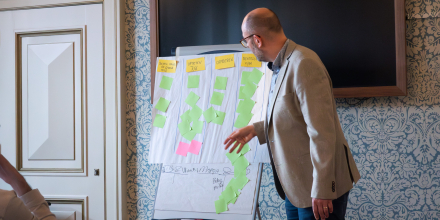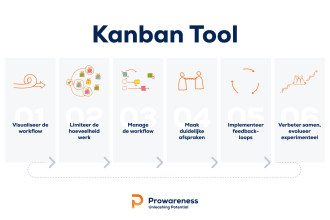Kanban
expertise
Kanban is a visual system for managing and improving work processes. By applying it structurally, an organization gains clear insight into workflow and tasks, which helps identify bottlenecks and optimize processes in a timely manner.

Why Kanban?
The Kanban board is essential for visualizing work processes. This central workspace manages a continuous flow of tasks, based on cycle time, without short sprints. The board helps teams reduce the time it takes to complete projects.
Kanban provides insight and control over work processes. By making workflow explicit, teams gain visibility and can effectively manage their work. This ensures smooth flow, improved cycle time, increased customer value and better predictability of task completion.
Six key steps
The Kanban Tool
The Kanban tool consists of six core steps that make up a cycle. By implementing regular feedback, team productivity can be measured and improved. The six steps are:
- Visualize the workflow
- Reduce the amount of work
- Manage the workflow
- Make clear agreements
- Plan feedback loops
- Continuous improvement

Puntsgewijs
-
Visualize the workflow
The first step in implementing Kanban is to visualize the workflow on a physical board. The whole team works together so that everyone agrees on what work is being done.
-
Reduce the amount of work
Limiting Work in Progress (WIP) is essential. By working with smaller quantities, the team encourages itself to complete tasks first.
-
Manage the workflow
Once the Kanban board is set up and a WIP limit is set, the workflow can be optimized. Good flow means that tasks on the Kanban board hardly ever get stopped.
-
Make clear agreements
Make agreements clear and note them on the board. Define WIP limits, the Definition of Done, and when new work is picked up. This significantly increases productivity.
-
Plan feedbackloops
By implementing daily, weekly or monthly feedback loops, team productivity can be measured. Recurring meetings help discuss process-related issues, thus improving workflow.
-
Continuous improvement
Kanban is a continuous improvement process. This allows teams to make small changes and improve gradually. By experimenting, teams applying the method evolve incrementally.

Kanban courses
Do you have questions about Kanban?
